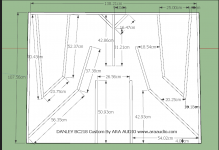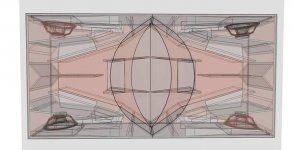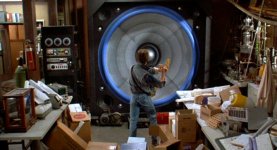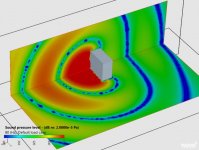Sublimacon,How do they keep the sealed chambers from lighting on FIRE with 4800Watts?
The DSL BC218 is rated for 3400 watts continuous, 13,600 watts peak. Although 1700 watts per sealed chamber is a lot, most of the chamber's surface area is being "fanned" by air being pumped by speaker excursion, and in it's usual sports stadium application, the duty cycle is relatively short (and dynamic range relatively high), other than at half-time where it might get 15 minutes of "continuous" use.
For EDM (electronic dance music), DSL's "usual" tapped horn arrangement with the driver's vents directly to the outside air would be far more effective in getting rid of the heat generated from program material that has as little as 3 dB crest factor.
Art
Weltersys,
First off your Keystone subs & Syntripy tops (sp?) designs are awesome!
Sorry about regurgitating the 4800Watt rating, thought I saw someone post that earlier. I think you nailed their intended application! As I've not seen these on tour rigs.
13,600 Watts peak single cab - are you pulling my leg? I mean it's DSL so I guess it has to be factual.
How did they rate that, like "peak watts squared, 5% duty-cycle of 1-microsecond at 1KHz". "World's first femto-second burst test tone".
Normally I would take that as creative marketing, like commonly seen in the car audio world. That same market segment ingeniously came up with the novel parameter of IIHBL (Instantaneous- If Hit By Lightning) amplifier wattage rating. Which theoretically, under perfect storm conditions is viable - LOL! These ratings can be seen prominently displayed all over gear sold at your local swapmeet.
But still, a stack of those BC218's would melt your face off at 20meters at -3dB from rated input.
Purpose built monsters - Wow!
First off your Keystone subs & Syntripy tops (sp?) designs are awesome!
Sorry about regurgitating the 4800Watt rating, thought I saw someone post that earlier. I think you nailed their intended application! As I've not seen these on tour rigs.
13,600 Watts peak single cab - are you pulling my leg? I mean it's DSL so I guess it has to be factual.
How did they rate that, like "peak watts squared, 5% duty-cycle of 1-microsecond at 1KHz". "World's first femto-second burst test tone".
Normally I would take that as creative marketing, like commonly seen in the car audio world. That same market segment ingeniously came up with the novel parameter of IIHBL (Instantaneous- If Hit By Lightning) amplifier wattage rating. Which theoretically, under perfect storm conditions is viable - LOL! These ratings can be seen prominently displayed all over gear sold at your local swapmeet.
But still, a stack of those BC218's would melt your face off at 20meters at -3dB from rated input.
Purpose built monsters - Wow!
13,600 Watts peak single cab - are you pulling my leg?
Why do I feel like Marty McFly when reading about these monsters??
Really interesting information here, thanks Patrick et al.
I wonder how well that Danley enclosure on post 1 would scale down.
Attachments
SynTripP is the proper spelling, but it's pronounced (sĭn'trip-ē) ;^).Weltersys,
First off your Keystone subs & Syntripy tops (sp?) designs are awesome!
13,600 Watts peak single cab - are you pulling my leg? I mean it's DSL so I guess it has to be factual.
While testing the B&C18SW115-4 in the Keystone subs, I blasted them with 120 volts of sine wave at 60 Hz several times, long enough for the mono bridged amplifier's mains breaker to repeatedly trip, nominally about 3600 watts into a single driver, before I figured out I was turning down the wrong output
It was shockingly loud (I was only two feet from the cabinet in a small room) , but the speaker did not sound particularly distressed. I don't think another 3 dB (7200 watts for one driver, 14,400 for two) would have killed it on the usual 6 dB music peaks typical of "normal" kick drums.
That said, at the impedance and excursion minima, it would not take more than a few seconds before coil melt down would occur if an amp sustained 6800 watts per driver.
Art
Last edited:
FLH scale well, basically cut dimensions in half and loose an octave off the bottom end.I wonder how well that Danley enclosure on post 1 would scale down.
weltersys,
Yeah if I had lots-o play cash I'd probably build a couple a sets of the SynTripP's as they seem extremely competent for their size. 2" exit comp-drivers are not on the menu with my typical build budgets.
Two feet away from 3600Watts feeding a Keystone in a small room - Ouch!!! I'm pretty use to loud, but if not expecting a point-blank cannon shot - holysh-t that would of scarred the crap out of me!
I really can't wrap my head around how these 4" VC's can absorb 7KW even on burst tones. I mean what is the wire gauge - like 16AWG tops? Just goes to show how advanced the Italians are in transducer tech. Especially for PA applications!
Yeah if I had lots-o play cash I'd probably build a couple a sets of the SynTripP's as they seem extremely competent for their size. 2" exit comp-drivers are not on the menu with my typical build budgets.
Two feet away from 3600Watts feeding a Keystone in a small room - Ouch!!! I'm pretty use to loud, but if not expecting a point-blank cannon shot - holysh-t that would of scarred the crap out of me!
I really can't wrap my head around how these 4" VC's can absorb 7KW even on burst tones. I mean what is the wire gauge - like 16AWG tops? Just goes to show how advanced the Italians are in transducer tech. Especially for PA applications!
Last edited:
The voice coils are four layers inside/outside wrapped on a 115mm (100mm is around 4") former, the wire is smaller than 16AWG, and is flat wound. The venting is very effective, heat is really pumped out, rather than just relying on convection.I really can't wrap my head around how these 4" VC's can absorb 7KW even on burst tones. I mean what is the wire gauge - like 16AWG tops? J
However they are doing it, it's getting done ;^)
13,600 Watts peak single cab - are you pulling my leg? I mean it's DSL so I guess it has to be factual.
How did they rate that, like "peak watts squared, 5% duty-cycle of 1-microsecond at 1KHz". "World's first femto-second burst test tone".
Normally I would take that as creative marketing, like commonly seen in the car audio world.
13,600 Watts peak is just the industry's practice of adding 6dB to continuous, ....so it's based solely on mathematical extrapolation.
Danley is as guilty as any when it comes to engaging in the "marketing peak specification wars".
weltersys,
Beyond marketing hype, more impressively you've actually hammered them with that level of power (repeatedly) and they servived it.
If they didn't cost a small fortune, I'd be tempted to pull a cone and see how caramelized the VC's enamel got? The Italians are using the best of the best on these drivers, so who knows they might be perfect?
Believe it or not: even though amp pwr is into the Cents/Watt range & superhero drivers are the norm now.
What I'm looking forward to is the next-gen ultra-efficient equipment. Imagine drivers with huge Xmax and instantaneous transient response, yet the efficiency of yesterday's low excursion horn drivers.
Today's driver tech is stuck at <10% acoustic pwr efficiency. In the future we'll be looking back at our current motor tech like 1930's field-coil drivers.
mark100,
I think you are correct on the marketing spin situation.
I've found many people in various (professional) fields of A/V rather ignorant to even basic levels of electronics theory, acoustic/video parameters, and proper setup and calibration. You'd be surprised how many "techs" just plug it in and say - hey it's up & running what more do you need? They are the "masses" who the hyperbole specs are catered to. And if it didn't work, the mfg's wouldn't bother with all that noise.
DSL probably found it necessary to conceded (to a point) to the maketing buzz BS. But their core market customers tend to be a little more versed in real performance, and DSL consistently delivers the goods!
Beyond marketing hype, more impressively you've actually hammered them with that level of power (repeatedly) and they servived it.
If they didn't cost a small fortune, I'd be tempted to pull a cone and see how caramelized the VC's enamel got? The Italians are using the best of the best on these drivers, so who knows they might be perfect?
Believe it or not: even though amp pwr is into the Cents/Watt range & superhero drivers are the norm now.
What I'm looking forward to is the next-gen ultra-efficient equipment. Imagine drivers with huge Xmax and instantaneous transient response, yet the efficiency of yesterday's low excursion horn drivers.
Today's driver tech is stuck at <10% acoustic pwr efficiency. In the future we'll be looking back at our current motor tech like 1930's field-coil drivers.
mark100,
I think you are correct on the marketing spin situation.
I've found many people in various (professional) fields of A/V rather ignorant to even basic levels of electronics theory, acoustic/video parameters, and proper setup and calibration. You'd be surprised how many "techs" just plug it in and say - hey it's up & running what more do you need? They are the "masses" who the hyperbole specs are catered to. And if it didn't work, the mfg's wouldn't bother with all that noise.
DSL probably found it necessary to conceded (to a point) to the maketing buzz BS. But their core market customers tend to be a little more versed in real performance, and DSL consistently delivers the goods!
To the OP,
I'm sorry we've completely Hi-Jacked your thread!
Unfortunately active (DSP) beam-shaping tech is not my forte. I'm more of a low-buck brute force kind of guy. I believe Meyer Sound and a few others have demo versions of their flown array control software. Those have advanced features to steer sound. Maybe an option is stacks of cheap drivers with multi-zone amps coupled with advanced software to pinpoint your backyard sound sys? Although, if bass spill is the biggest concern two small laterally placed cardioid sub arrays would be the simplest route. Then only the neighbors directly behind your lot would get blasted?
I'm sorry we've completely Hi-Jacked your thread!
Unfortunately active (DSP) beam-shaping tech is not my forte. I'm more of a low-buck brute force kind of guy. I believe Meyer Sound and a few others have demo versions of their flown array control software. Those have advanced features to steer sound. Maybe an option is stacks of cheap drivers with multi-zone amps coupled with advanced software to pinpoint your backyard sound sys? Although, if bass spill is the biggest concern two small laterally placed cardioid sub arrays would be the simplest route. Then only the neighbors directly behind your lot would get blasted?
From his picture, neighbors behind him are half a mile away.To the OP,
I'm sorry we've completely Hi-Jacked your thread!
Unfortunately active (DSP) beam-shaping tech is not my forte. I'm more of a low-buck brute force kind of guy. I believe Meyer Sound and a few others have demo versions of their flown array control software. Those have advanced features to steer sound. Maybe an option is stacks of cheap drivers with multi-zone amps coupled with advanced software to pinpoint your backyard sound sys? Although, if bass spill is the biggest concern two small laterally placed cardioid sub arrays would be the simplest route. Then only the neighbors directly behind your lot would get blasted?
Jn
For my hornresp model, I used this folding that I found online. It's a different folding then what I posted about five years ago.(1)
For the driver, I used the B&C 18TBX100. I think that this box will likely work with a variety of eighteens. It's a fairly straightforward FLH from what I can see, just very BIG :O
Sooo, I'm thinking about building this clone of the BC218 for at festival (because I like the directivity), but I started thinking about what happens to all of the heat produced by the voice coil in the back chamber? It doesn't have anywhere to go, and thinking about hitting the drivers with 600 watts makes me kinda scared of the long term consequences..
I've already modelled the speaker in fusion360, so I'm hoping your simulation is in the ballpark of the real life performance
Hello Mr
lg brudertuck
Patrick Bateman
Do you have the whole messurmets and the plans ,to build The BC218 Box?lg brudertuck
Patrick Bateman's Hornresp inputs in the OP were based on the fold pattern of a shorter horn posted here:
https://www-araaudio-com.translate....tr_sl=id&_x_tr_tl=en&_x_tr_hl=en&_x_tr_pto=sc

The shorter version is probably based on this version:

Which may have been based on this drawing TB46 made after my comments :

Anyway, that's all I got
Art
https://www-araaudio-com.translate....tr_sl=id&_x_tr_tl=en&_x_tr_hl=en&_x_tr_pto=sc

The shorter version is probably based on this version:

Which may have been based on this drawing TB46 made after my comments :
Anyway, that's all I got
Art
- Home
- Loudspeakers
- Subwoofers
- NIMBY

